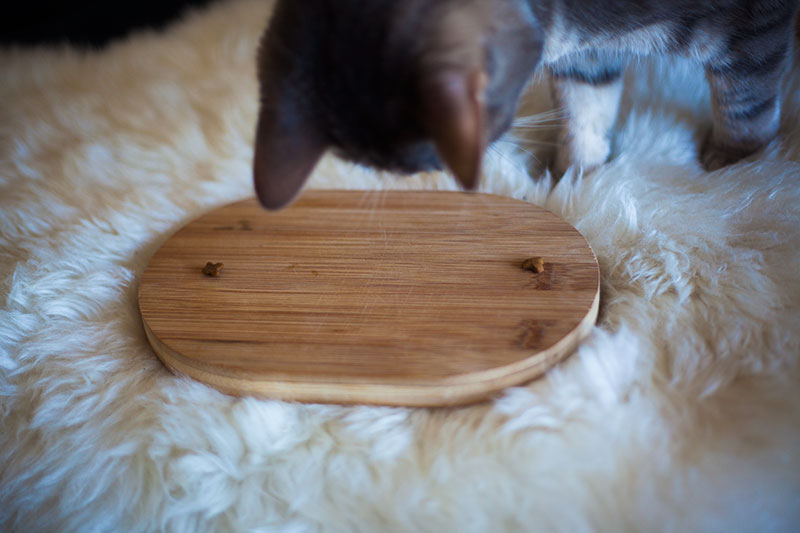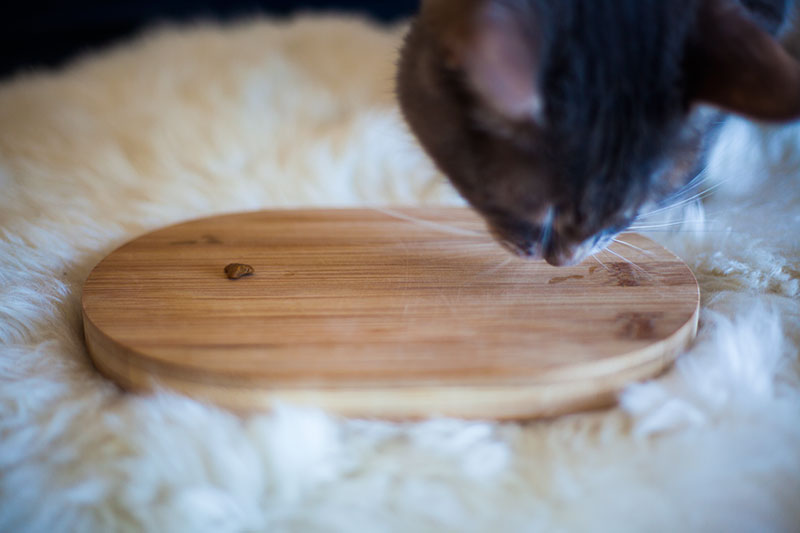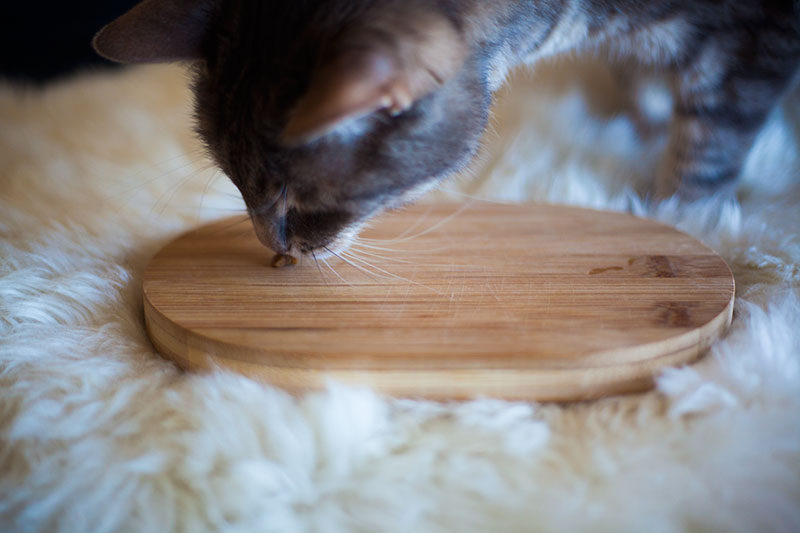Trying to figure out whether or not bamboo is safe for cats? The answer may appear to be a straightforward yes at first glance.
After all, the single best source online for determining whether a substance is toxic to a pet – the ASPCA website – states outright that bamboo is non-toxic to both cats and dogs.
Unfortunately, however, as you likely were able to tell from the title, things are a little more complicated than they first appear.
The whole story? Not everything we colloquially refer to as bamboo is actually bamboo.
In fact, there are quite a large number of plants that have the word “bamboo” in at least one of their common names that are not bamboo at all.
Many of these are safe for cats and dogs to be around and ingest, but there are also a couple dangerous and toxic plants alongside the non-toxic varieties.
Thus, at the end of the day – whether or not the bamboo plant you have is toxic to cats really depends on the particular variety of plant you’ve got on your hands.

Is Bamboo Poisonous to Cats?
As stated in the intro: bamboo proper, which has the scientific name “phyllostachys aurea” is non-toxic to plants. This means, if a cat has a nibble of a bamboo leaf, no adverse effects should take place.
Don’t have bamboo proper? Trying to figure out if the plant you’ve got is toxic or non-toxic to cats? Search through the following lists to find the plant you’ve currently got.
It includes as many plants with “bamboo” in their common name as I’ve been able to find, as well as many plants that are sometimes mislabelled when sold.
My advice: search for your plant by its scientific name if you possibly can, as that’s the best way to make sure what you have hasn’t been mislabelled.
Plants Toxic to Cats With Bamboo In Their Name
- Scientific name: Nandina domestica
Sometimes called: Heavenly Bamboo, Sacred Bamboo, & Nandina - Scientific name: Dracaena spp
Sometimes called: Lucky Bamboo, Dracaena, Corn Plant, Cornstalk Plant, Ribbon Plant, Dragon Tree, Money Tree
Plants Non-Toxic to Cats With Bamboo In Their Name
- Scientific name: Phyllostachys aurea
Sometimes called: Bamboo, Golden Bamboo, Fishpole Bamboo - Scientific name: Chamaedorea elegans
Sometimes called: Reed Palm, Bamboo Palm, Miniature Fish Tail Dwarf Palm, Parlor Palm, Good Luck Palm* (*note, this is not the same as “Lucky Bamboo,” which is in fact toxic to cats and thus listed in the section above). - Scientific name: Smilax laurifolia
Sometimes called: Bamboo Vine, Blaspheme vine, Laurel-leaved Greenbrier - Scientific name: Smilax walteria
Sometimes called: Red Berried Greenbrier, Red Berried Bamboo

What Happens If My Cat Eats Part of a Toxic Plant?
The side effects of your cat having a nibble on one of the toxic plants listed above is up for debate.
According to the ASPCA website, very serious side effects can take effect; including, but not limited to:
- Vomiting (occasionally with blood)
- Depression
- Anorexia
- Hypersalivation
- Dilated pupils
- Weakness
- A lack of coordination
- Seizures
- Coma
- Respiratory failure
- And very rarely, death
Some who have had first hand experiences with their pet eating either nandina domestica or dracaena spp report online that they did not notice any side effects. My advice: don’t take chances.
If your pet has ingested any one of the toxic varieties, immediately call up your vet and let him or her know which plant your pet has ingested, how much you assume he or she ate, and (obviously) remove the plant from the cat’s vicinity.
That being said, don’t immediately jump into panic mode, because the very serious side effects don’t seem to pop up all that frequently, especially if your cat did not ingest very much of the plant in the first place.

Your Experiences With Cats & Bamboo?
Do you have any experiences with cats and bamboo? Have you any non-toxic plants at home with “bamboo” in their common name? Which varieties do you have?
Did you know toxic plants with “bamboo” in their common names existed? Did you need to double check a plant you had at home was not one of these?
Have you ever had experience with a cat nibbling on a toxic plant? Which one? What were his or her symptoms and what did your vet say about potential dangers when you called him or her up?
Would love to learn about your experiences in the comments!

The bamboo that I have around my home is this one safe every time my one cat gets out she goes to this bamboo she likes to chew on I didn’t know there were so many kinds. She shows no signs of illness neither do my other ones. So how can I tell if it’s bad.
Any reports on ‘hardy clumping bamboo’ Fargesia?
Hello! Please, I still don´t know if Fargesia robusta ‘Campbell’, a kind of bamboo that one of my cats love eating, is toxic or not.
I’m just a little confused by the alternative names, and/or subdivisions listed under Dracanae. I have a corn plant and after bringing it home, I noticed my girl was oddly attracted to it, so I did some searching and naturally, I discovered it was toxic, so I moved it outside. But it looks nothing like a Money Tree, which I also have, and is non-toxic. The same goes for the lovely Dragon Tree I got and discovered wasn’t good to have…outside, but again, definitely not the same as the money tree or the “lucky bamboo” I considered. Also I’ve seen “ribbon plant” used by the ASPCA website as an alternative for Spider Plant, which is very cat-friendly. These being listed as under the same umbrella is a bit misleading and could cause people with safe Money Plants and “Ribbon Plants” to discard them or be overly concerned. Likewise, those who know those plants to be safe, might think dragon plants and corn plants, under the same umbrella are safe also, and they aren’t. I was just hoping maybe a little extra name comparison and research would be helpful for your great blog. Thanks!
The issue as I see it is that sometimes, plants are listed as being/called what they are not, so I wanted to list all the names Dracane and such are “sometimes called” instead of just listing what it really is, so pet owners could be wary.
If I changed “Common names” to “Sometimes called”, do you think that would make what I was trying to do a little more clear?
As far as I know Dracaenas can cause kidney damage. Mild damage doesn’t show, but it is there and may accumulate. At around 70% damage, symptoms begin to show.
So better make sure your cat can’t reach dracaenas. Because they seem to taste good… one of my cats likes to bite in it 🙁
I have Dracena which is labeled as “Message Bamboo”
My cat likes to lick it, but doesn’t seem bite it.
Changed the wording up – hopefully that makes what I was trying to say a little clearer!
I want all your posts by e-mail weekly only is that possible? please let me know
Hey Crystal! Sorry, I only have one way to subscribe, and that’s whenever I’ve updated the blog with a new post. You can always feel free to unsubscribe and just pop in once a week, though!
I’ve actually never thought about this before. Great article 😀
Thanks, John!
When Angel and Chuck were kittens, I chucked out any potted plant in the house that even remotely could be toxic to cats. Dracaenas especially. Now we only have spider plants and Christmas cactus. I didn’t know about bamboo!
Very nice work! Boy do I love the look of spider plants. Christmas cactus I didn’t even realize was non-toxic! Very cool.
thanks so much for this post! You know, I often see cat furniture that states that it is made out of bamboo and I am always hesitant to purchase it (and never have)…why? Some cats (like mine), chew various things and I think that might be a good example of what you are referring to. I am doubting that some cat furniture that touts itself as being bamboo is REALLY bamboo, (or the safe kind that you mentioned) Great post!
You know, I really hadn’t thought about that before!
For some reason, my gut tells me that most things that claim they’re made out of bamboo pretty much have to be for a couple reasons. First, bamboo grows *so* quickly and gets to be much taller than most similar looking plants (including the other house plants that have “bamboo” in their common names), and I’d assume making wood out of bamboo would thus be more affordable and ideal for mass production because of its rapid growth and the massive size it can get to. Second, I also feel the wood grain from plants besides bamboo would look different from bamboo proper? Bamboo has a very characteristic “look” once it’s made into wood if you know what I mean.
Who on earth knows, though – I would love to have more clarity on this topic and would love it if someone more knowledgeable than I would chime in. My intuitions could be completely false! Either way – good on you for defaulting to being on the safe side!